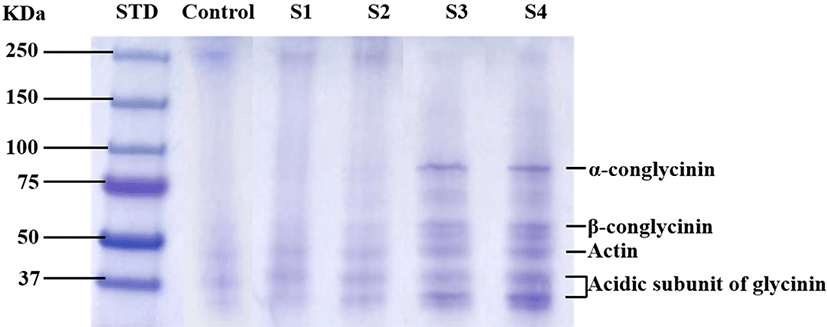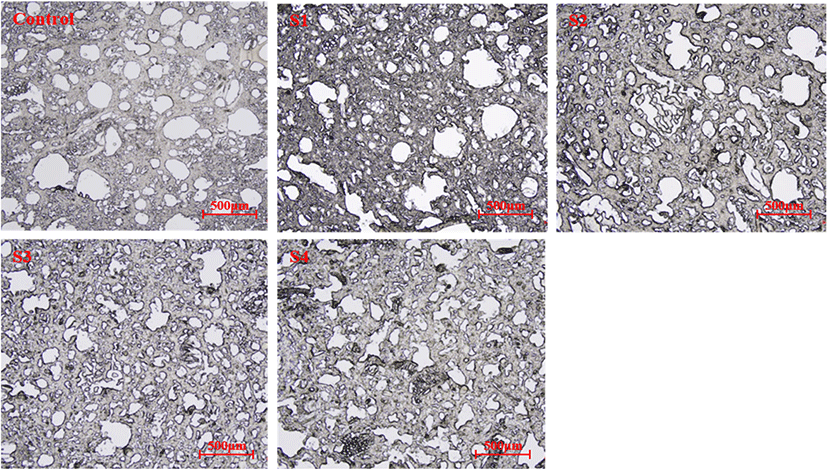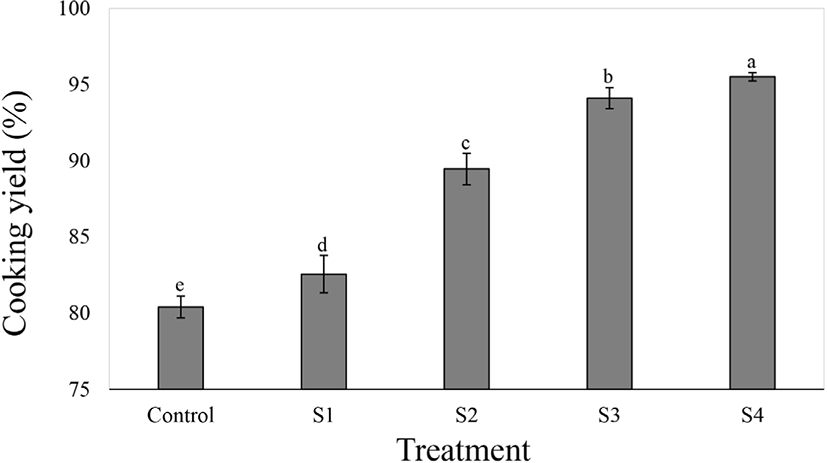Introduction
The global development of industrialization has induced a worldwide increase in meat-based diets, including processed meat (You et al., 2020). Among the various types of meat, chicken is a popular source of protein due to its low fat, high protein, and balanced amino acid contents. It is therefore recognized by modern consumers as an ideal meat source in the current trend towards healthy eating (Hwang et al., 2020; Kawecki et al., 2021). Consequently, chicken consumption worldwide increased by 2.9% from 6.08 million tons in 1999 to 6.25 million tons in 2015; it is expected to further increase by another 2.4% from 2015 to 2030 (Bruinsma, 2017).
Meat is an important source of protein that is rich in essential amino acids such as histidine, lysine, and methionine. However, some consumers have a negative perception towards meat due to the concern that excessive meat consumption can lead to an increase in the incidence of metabolic diseases such as cardiovascular diseases and due to ethical issues such as animal welfare (Argel et al., 2020; Cha et al., 2020). To resolve the concerns, vegetable proteins are attracting attention as an alternative to animal proteins (Park, 2021). When vegetable proteins are incorporated into meat products, their nutrients and dietary fibers assist in improving the nutritional and quality characteristics of the products, as well as reducing their production costs due to an increase in water holding capacity (Besbes et al., 2008). Furthermore, vegetable proteins exert positive effects such as preventing vascular diseases, being anti-cancerous, and providing antioxidant effects. Among the various available vegetable proteins, soybeans (Glycine max [L.] Merrill) are often used as protein supplements and protein substitutes due to their aforementioned effects and their high protein content (Chalvon-Demersay et al., 2017; Parniakov et al., 2018).
Soybeans are widely utilized in various products, such as tofu, soybean milk, and cooking oil, due to their excellent processing quality. Furthermore, their high protein content (as high as approximately 40%) means that they are among the most commonly used vegetable proteins (Kouakou et al., 2019). In addition, they contain many biologically active substances, such as isoflavone, which prevents adult diseases; saponin, which excels in preventing cancer; and lecithin, which reduces cholesterol levels. Thus, soybeans are often utilized as health products (Muramatsu et al., 2017). Furthermore, soybean proteins have been used as additives to enhance the quality characteristics of meat products, and previous studies have been conducted into incorporating vegetable proteins into meat products to fulfill the role of meat or fat (Park et al., 2020; Polizer et al., 2015; Tarté et al., 2020).
However, although researches have been conducted into processed meat products produced by incorporating soybean proteins, there have been few studies on assessing their quality. Therefore, in this study we aimed to produce chicken breast Vienna sausages by partially substituting meat with soybean protein and to compare their quality characteristics to determine their optimal addition ratio.
Materials and Methods
The base of the chicken Vienna sausages were made with chicken breast (Maniker, Seoul, Korea) and pork back fat; they were ground using a grinder (PA-82, Mainca, Barcelona, Spain). The emulsion manufactured with soybeans (ES) was manufactured with soybean (Nonsan, Korea; moisture: 12.42%, crude protein: 43.36%, crude fat: 15.10%, crude ash: 5.02%, pH: 6.51). Also to form of emulsion, added vital wheat gluten (Vegefood, Namyangju, Korea; pH: 6.60). It was mixed using a hand blender (HR2652, Philips, Amsterdam, Nederlands) with 35% soybean, 25% vital wheat gluten, and 40% water of the ratio (Cho et al., 2014). After the preparation of the main materials, emulsified materials were manufactured using a bowl cutter (K-30, Talsa, Valencia, Spain). The formulations of the Vienna sausages were taken from Mousavi et al. (2019); they are presented in Table 1. The Vienna sausage emulsions were filled into natural pork intestine casings using a stuffer (EM-12, Mainca), and cooked for 30 min in a chamber at 80°C (10.10ESI/SK, Alto Shaam, Menomonee Falls, WI, USA) with a core temperature was 70°C. After cooked, each sausage was cooled at 10°C for 20 min and stored at 4°C and used for the experiment.
S1, sausage containing 10% emulsion manufactured with soybeans and 50% chicken meat; S2, sausage containing 20% emulsion manufactured with soybeans and 40% chicken meat; S3, sausage containing 30% emulsion manufactured with soybeans and 30% chicken meat; S4, sausage containing 40% emulsion manufactured with soybeans and 20% chicken meat; NPS, nitrite pickling salt (60 ppm).
The samples for pH analysis were prepared by mixing samples with distilled water (1:4, v/v) using an Ultra Turrax homogenizer (HMZ-20DN, Pooglim Tech., Seongnam, Korea) for 1 min at 6,991 g. pH was then determined using a pH meter (Model S220, Mettler-Toledo, Schwerzenbach, Switzerland).
Samples’ cutting surfaces were evaluated using a colorimeter both before and after cooking (CR-10, Minolta, Tokyo, Japan, calibrated with a white plate, CIE L*: +97.83, CIE a*: –0.43, and CIE b*: +1.98); the lightness (CIE L*), redness (CIE a*), and yellowness (CIE b*) were recorded.
The proximate compositions of the chicken Vienna sausages were determined using Association of Official Analytical Chemists (AOAC) guidelines (AOAC, 2010). Moisture content was determined by drying samples in an oven at 105°C, the crude protein content was determined via the Kjeldahl method (AOAC 928.08), crude fat content was determined via the Soxhlet method (AOAC 991.36), and the crude ash content was determined using the dry ashing method at 550°C (AOAC 920.153).
Relevant protein levels were assessed with SDS-PAGE analysis using gradient gel (Mini-protein TGX gels 4%–20%, Bio-rad, Hercules, CA, USA). The supernatants of the samples were mixed with 3 mM phosphate buffer and 5 sample buffer to make 200 μg/mL of total protein volume. Then, 15 μL of each sample was added to each well of the gel, before being processed for 1 h and 20 min. The gel was then removed and fixed in a fixing solution, incubated overnight using a rocker, and stained with Coomassie brilliant blue for 20 min, while under gentle agitation. The dye was removed with a destaining solution for 1 h, following which the gel was stored in a storage solution and then scanned.
The samples for microphotograph analysis were stored at –80°C in a deep freezer (TSE320GPD, Thermo Fisher Scientific, MA, USA) for 24 h. The samples were then sliced into 10 μm slices using a cryostat (CM3050S, Leica Biosystems, Wetzlar, Germany). The sliced samples were then observed and scanned using an upright clinical microscope (Eclipse Ci-L, Nikon, Tokyo, Japan).
The cooking yields of the samples were weighed both before and after cooking and then after cooling at 10°C for 20 min. The cooking yield was determined from these weights; it was calculated with the following formula.
TPA was measured by citing the measurement methods of Shin and Choi (2021). The cooked samples were cut into ф 2.5×2.0 cm (diameter×height) pieces. Sample texture profile analysis were measured using a texture analyzer (TA 1, Lloyd, Largo, USA); the machine analyzing conditions were as follows: cylinder probe of 100 mm with a pre-test speed of 2.0 mm/s, a post-test speed of 5.0 mm/s, a maximum load of 2 kg, a head speed of 2.0 mm/s, a distance of 8.0 mm, and a force of 5 g. Hardness (kg), springiness, and cohesiveness were measured and recorded; these values were utilized to calculate gumminess (hardness×cohesiveness, kg) and chewiness (springiness×gumminess, kg).
All experimental results were assessed after a minimum of three repeated trials. Statistical analyses were performed using SAS® (version 9.3 for window, SAS Institute, Cary, NC, USA); results are indicated herein as mean values and SD. Analysis of variance (ANOVA) and Duncan’s multiple range tests were performed to verify the significance of each difference in each characteristics.
Results and Discussion
Table 2 shows the results of pH and color of chicken Vienna sausages, according to the amount of ES added. The pH before cooking significantly increased with increasing ES content (p<0.05). The pH after cooking tended to increase with increasing ES content; the S3 and S4 showed significantly higher values than the other samples and the control (p<0.05). The results of this study were similar to the results reported by Dzudie et al. (2002), who stated that the pH of beef sausage increased as the proportion of soybean protein substitutes increased. The pH of soybeans is known to be approximately 6.6; it is determined by the acidic subunits incorporated in soybeans (Chang, 1988; Lu et al., 2020). Therefore, this result suggests that the pH of soybeans can induce an increase in processing yield when using ES as a meat substitute.
S1, sausage containing 10% emulsion manufactured with soybeans and 50% chicken meat; S2, sausage containing 20% emulsion manufactured with soybeans and 40% chicken meat; S3, sausage containing 30% emulsion manufactured with soybeans and 30% chicken meat; S4, sausage containing 40% emulsion manufactured with soybeans and 20% chicken meat.
The lightness before cooking showed that the S4 exhibited significantly higher values than the control and other samples (p<0.05). Furthermore, the lightness after cooking was significantly higher in the control than in all the other samples (p<0.05). The relatively lower lightness observed in the ES treated samples after cooking might be resulted from the Maillard reaction through the browning of soybean proteins (Kwok et al., 1999). Significantly higher redness levels were observed in the control than in the ES treated samples, both before and after cooking (p<0.05). These results could be due to the absence of any pigments that affect redness (such as myoglobin) in soybean proteins. Thus, the proportion of meat pigment in the overall emulsions decreased with increasing ES content (Adeniyi et al., 2018). There was no significant difference in yellowness before cooking between the control and the ES treated samples, but the S4 showed a significantly higher yellowness value than the control and other samples after cooking (p<0.05). Yoon and Kim (2007) reported that the yellowness of the soybean protein increased with increased heating temperature due to the Maillard reaction. Thus, it is thought that in this study the Maillard reaction of ES (when used to replace chicken breast) affected the lightness and yellowness. Therefore, it is assumed that the lack of meat pigments can be resolved through the substitution with the Maillard reaction and improves quality.
The proximate composition of the chicken Vienna sausages according to the amount of ES added are illustrated in Table 3. There was no significant difference in the moisture and ash contents according to the substitution ratio of ES. S2, S3, and S4 showed significantly higher protein content values than the control (p<0.05). However, S4 also showed a significantly lower crude fat content than the control (p<0.05). These results could be due to differences in the proximate compositions of chicken breast and soybeans. Chicken breast is known to be comprised of approximately 22.04% protein, whereas soybean comprises approximately 40.00% protein (Javaid et al., 2017; Krishnan et al., 2000). Thus, increasing the ES content increased the protein contents of the produced sausages (Ali et al., 2007; Jung et al., 2003). Thus, here the protein content may have increased due to the increased ES content, which resulted in a relative decrease in the fat content.
S1, sausage containing 10% emulsion manufactured with soybeans and 50% chicken meat; S2, sausage containing 20% emulsion manufactured with soybeans and 40% chicken meat; S3, sausage containing 30% emulsion manufactured with soybeans and 30% chicken meat; S4, sausage containing 40% emulsion manufactured with soybeans and 20% chicken meat.
Fig. 1 illustrates the SDS-PAGE analysis of the chicken Vienna sausages according to the amount of ES treated. Soybean proteins are composed of four fractions: α, α′, β-conglycinin, and glycinin. Among them, glycinin is composed of acidic proteins and basic proteins, its quaternary structure has organized larger hydrophilic area than meat proteins (Salas et al., 2013). The SDS-PAGE results revealed that the contents of α-conglycinin (71.5–75.0 kDa), β-conglycinin (48.4–55.2 kDa), and acidic proteins (34.0–38.9 kDa) all tended to increase as the amount of ES treated increased. Heating the soybean proteins did not destroy β-conglycinin, acidic proteins, or basic proteins, implying that the increase in the contents of β-conglycinin, acidic proteins, and basic proteins in the SDS-PAGE analyses resulted from the increased proportion of supplemented soybean proteins (Peñta-Ramos and Xiong, 2002). Furthermore, Wang et al. (2017a) reported that β-conglycinin exhibits antioxidant activity when hydrolyzed. Implying that if soybean proteins were to be used as substitutes for some meats, it would be possible to produce functional meat products that exhibit antioxidant activity through the hydrolysis of β-conglycinin during the digestion process in the body, while still maintaining protein content levels similar to those of the existing meat products.

Fig. 2 shows cross-sections of chicken Vienna sausages with differing amounts of ES treated. We confirmed that the sizes of the white fat globules decreased with increasing ES content. Paulson and Tung (1989) found similar results when using vegetable protein emulsions to partially replace meat, stating that increasing the substitution ratio of soybean protein decreased pore size, which in turn decreased the sizes of the fat globules. And soybean proteins are mostly made up of water-soluble proteins, meaning that they exhibit an enhanced emulsifying capacity. This increases the bonding between the protein and the fat molecule, and ultimately produces a sausage with a more delicate structure (Ramezani et al., 2003). Furthermore, the large aggregate size of soybean protein is accompanied by a large hydrophobic domain on surfaces. This means that the emulsifying capacity would increase during the initial emulsion process, causing a relative decrease in fat globule size (Wang et al., 2017b). Therefore, adding ES can enable the production of more structurally stable sausages.

The cooking yields of chicken Vienna sausages with differing amounts of ES treated are illustrated in Fig. 3. The cooking yields can be affected by various factors, such as temperature, pH, viscosity, the functionality of the myofibrillar protein, and fat globules (Trindade et al., 2011). The result of cooking yields in this study showed that the cooking yields significantly increased with increasing ES substitution ratio (p<0.05). These results are similar to those obtained during a study into pork patties conducted by Argel et al. (2020), which stated that the cooking yields increased as the meat was partially replaced with soybean protein. Gao et al. (2015) also reported that the structure of a sausage becomes refined by water-soluble proteins within the added soybean and that the cooking yields can be enhanced by reducing the excretion of moisture. Taken together, the increase in cooking yields observed in this study may result from the delicate protein structures of the sausages arising from an increase in the substitution ratio of soybean proteins.

Table 4 displays the TPA measurement results of chicken Vienna sausages with differing amounts of ES treated. The hardness, gumminess, and chewiness of the control was significantly higher than the samples treated ES (p<0.05). Bernasconi et al. (2020) reported that the decrease in the hardness and chewiness of new patties in which soybean proteins were used as meat substitute may have resulted from an increase in moisture retention triggered by soybean protein; the same mechanism may have affected the results of our study. Also through the SDS-PAGE results, increasing of ES brings increase of glycinin contents, and it made Vienna sausages’s structure more densely. And it increased water holding capacity and made softer texture. There was no significant difference in the springiness between the control and the other samples, while the S2, S3, and S4 exhibited significantly higher cohesiveness values than the control (p<0.05). Biswas et al. (2011) reported that incorporating soybean proteins can effectively increase the cohesiveness of emulsified meat products. These results can be explained by the adhesion of meat protein particles that occurs due to the film-forming properties of the soybean proteins. And this ultimately increases the cohesiveness (Wolf, 1970). Therefore, we believe that the replacement of chicken with ES, as featured in this study, increased the cohesiveness of the resulting sausage. This subsequently increased cooking yields; it is also expected that products containing ES can exhibit softer textures to those of the conventional meat products.
S1, sausage containing 10% emulsion manufactured with soybeans and 50% chicken meat; S2, sausage containing 20% emulsion manufactured with soybeans and 40% chicken meat; S3, sausage containing 30% emulsion manufactured with soybeans and 30% chicken meat; S4, sausage containing 40% emulsion manufactured with soybeans and 20% chicken meat.
Conclusion
Crude protein content and SDS-PAGE analyses suggested that using ES as a meat substitute for chicken breast-based Vienna sausage improved protein quality. Microphotographs showed smaller fat globule in S3 and S4. And the analysis of cooking yields increased with increasing percentage of ES. These results suggested that substitution of meat by ES brought improvement of emulsifying activity. As the percentage of ES increased, hardness were decreased rather cohesiveness were increased. Especially S3 showed lowest hardness and highest cohesiveness. And these results means ES softened texture by increasing cooking yields and making delicate structure. In conclusion, using each 30% of ES and chicken breast is the suitable ratio for developing protein-enriched meat products.













